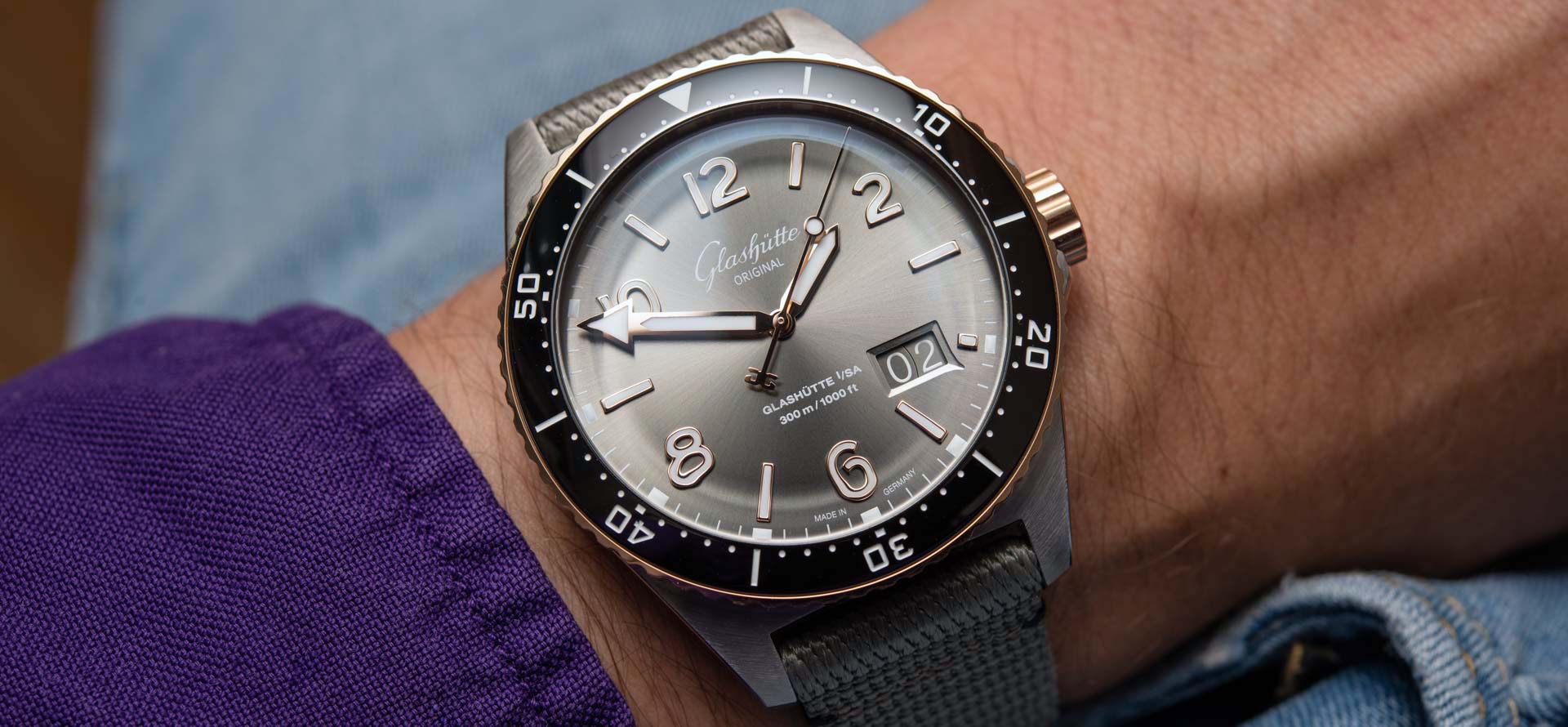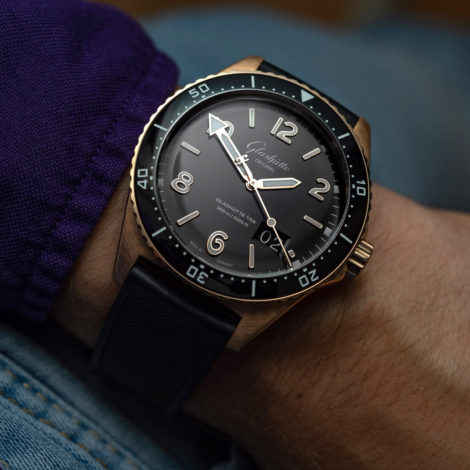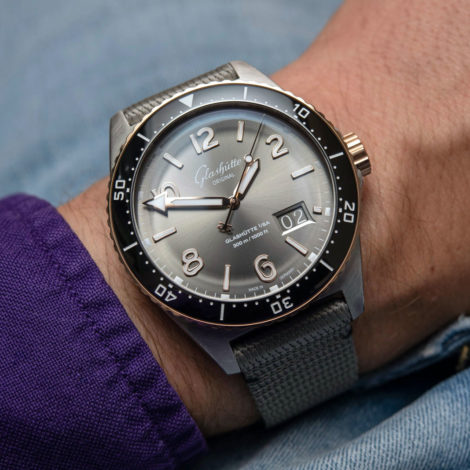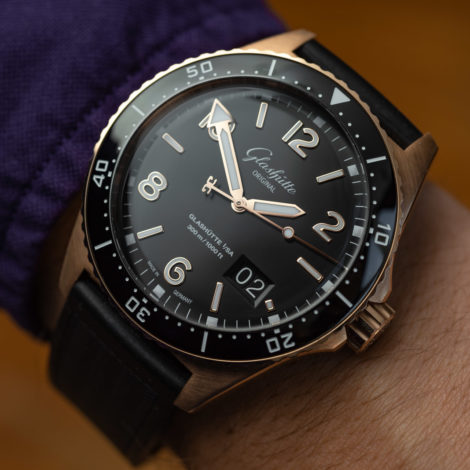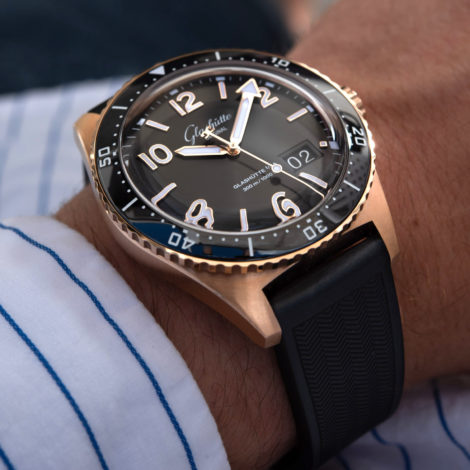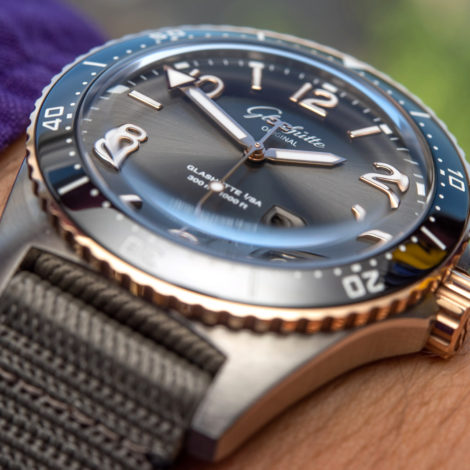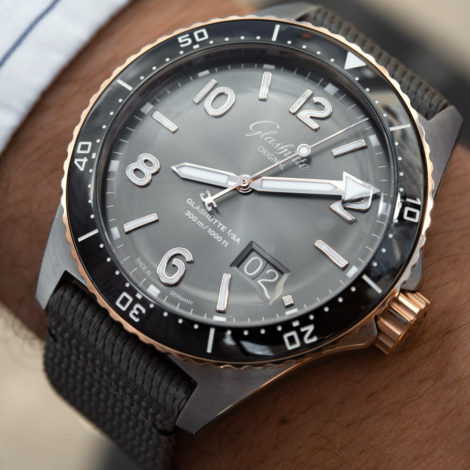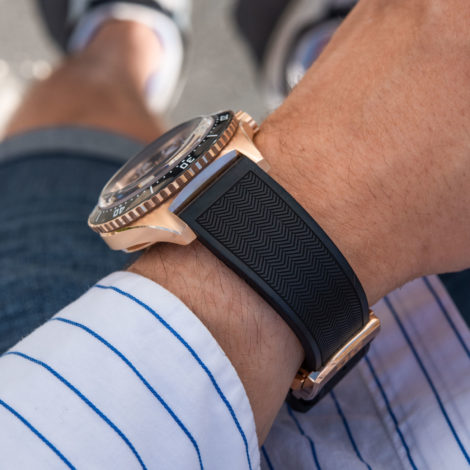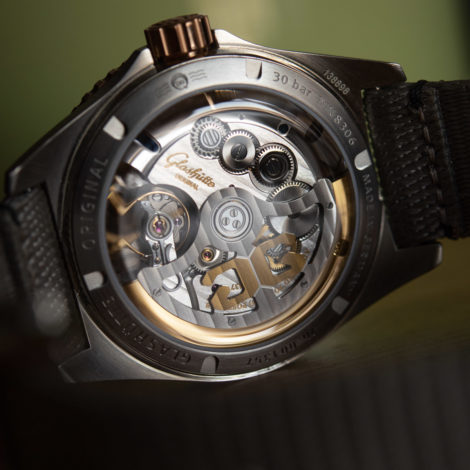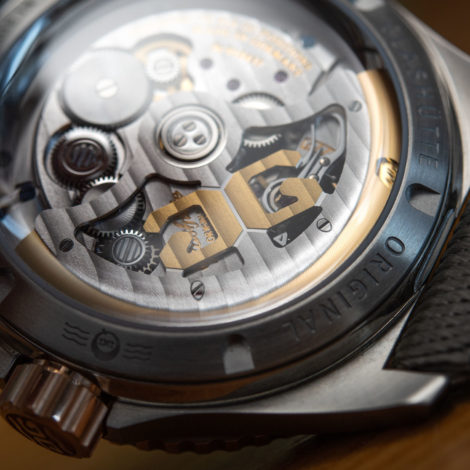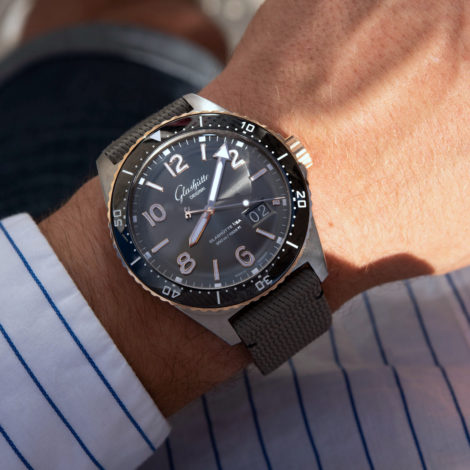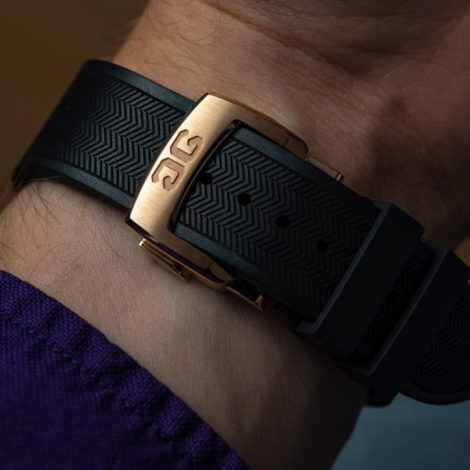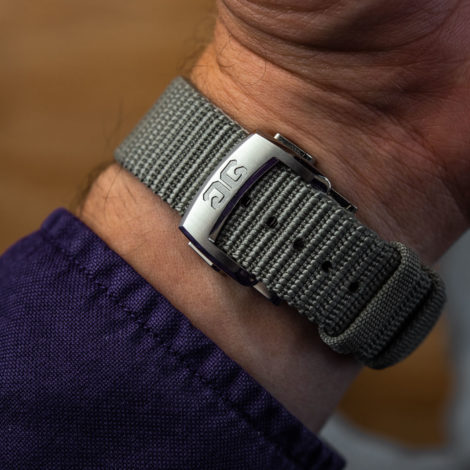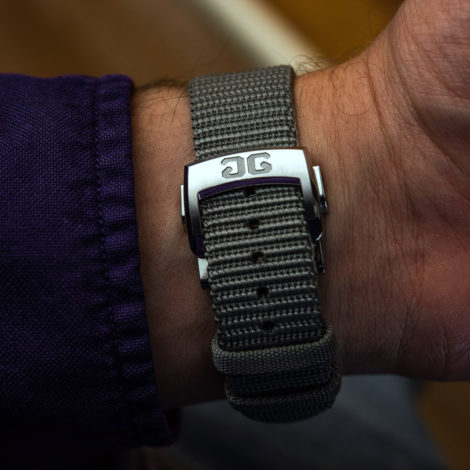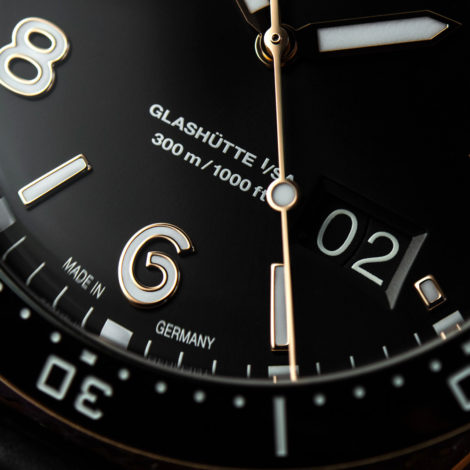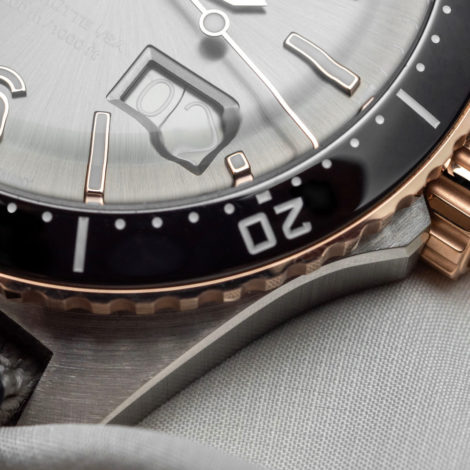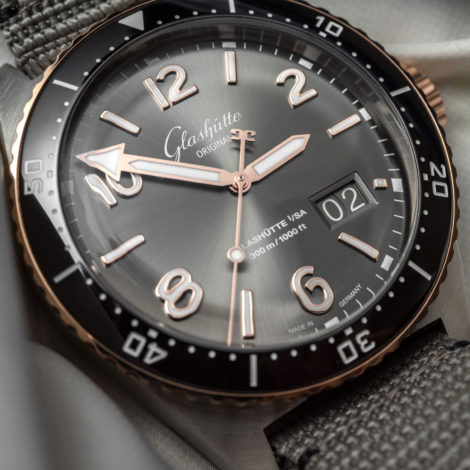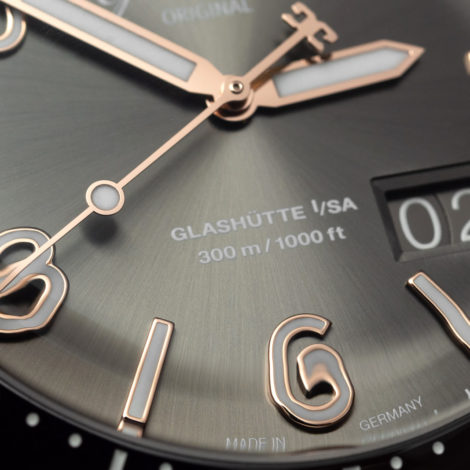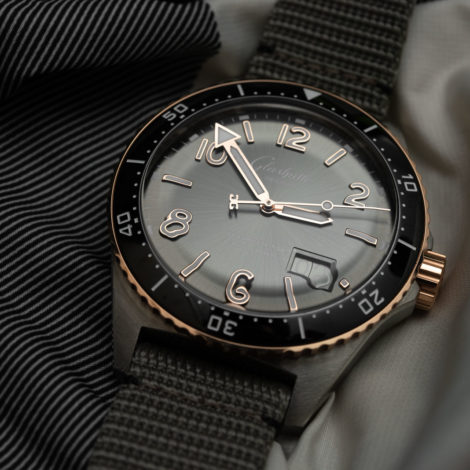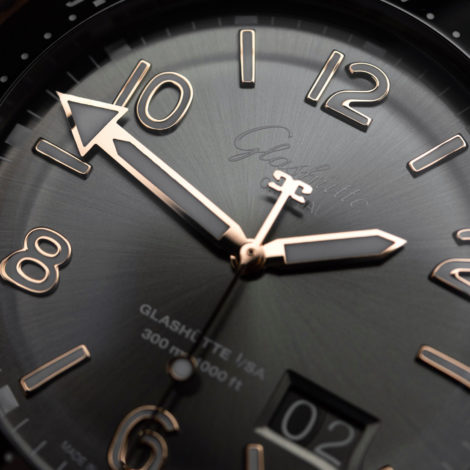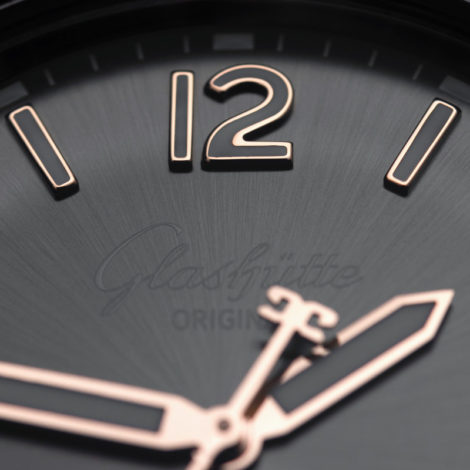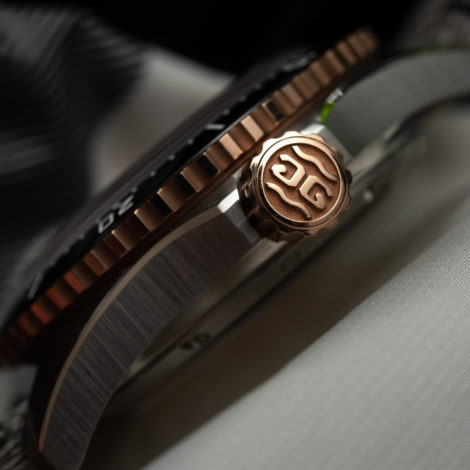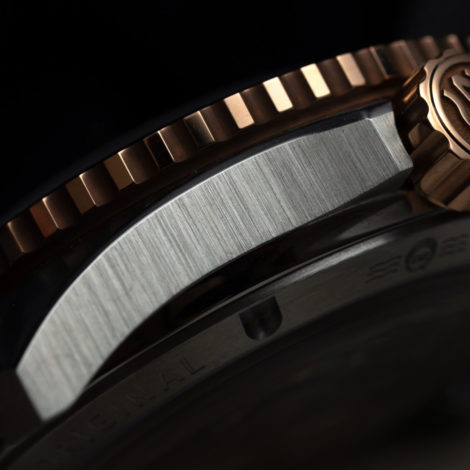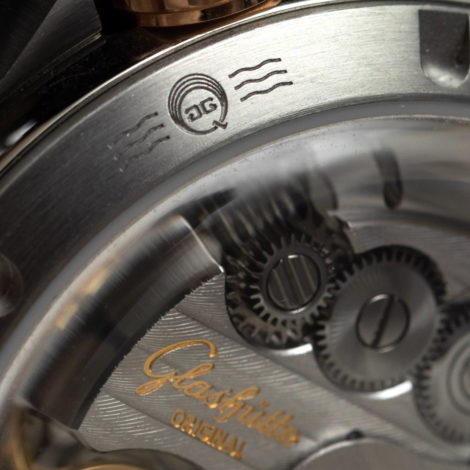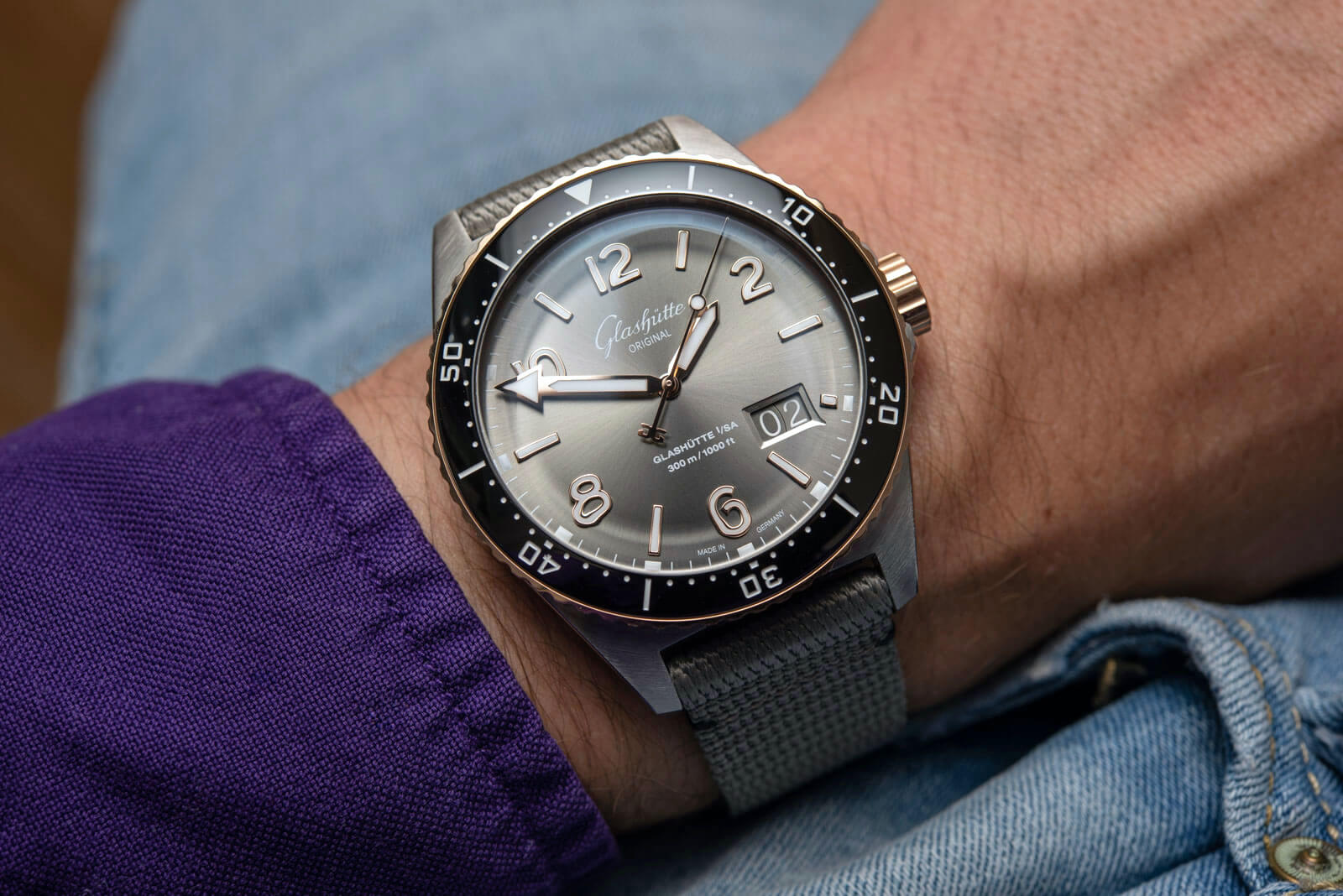 The Glashütte Original SeaQ line of watches is slowly but surely shaping up into a full-fledged range of sports-dive watches. Since such a thing had been missing for a good number of years from this Saxon manufacture’s portfolio, it’s interesting to see the pace and dedication with which it is entering the lucrative market of… no, not steel bracelet-equipped, octagonal luxury sports watches, just good-old go-anywhere, rugged timepieces. The Glashütte Original SeaQ Panorama Date has just received a “bi-color” two-tone model in steel and gold, as well as in solid 18k red gold.
The Glashütte Original SeaQ line of watches is slowly but surely shaping up into a full-fledged range of sports-dive watches. Since such a thing had been missing for a good number of years from this Saxon manufacture’s portfolio, it’s interesting to see the pace and dedication with which it is entering the lucrative market of… no, not steel bracelet-equipped, octagonal luxury sports watches, just good-old go-anywhere, rugged timepieces. The Glashütte Original SeaQ Panorama Date has just received a “bi-color” two-tone model in steel and gold, as well as in solid 18k red gold.
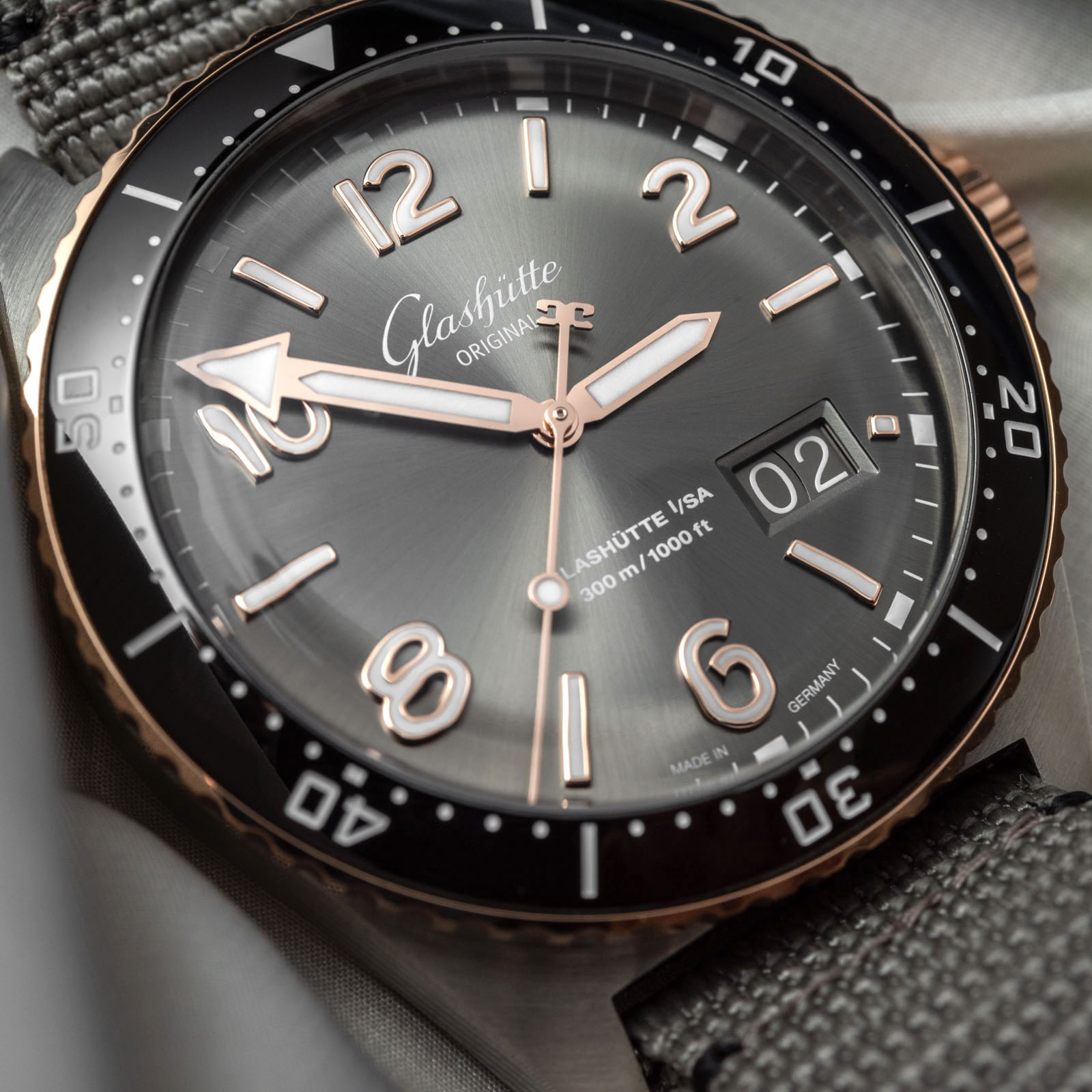
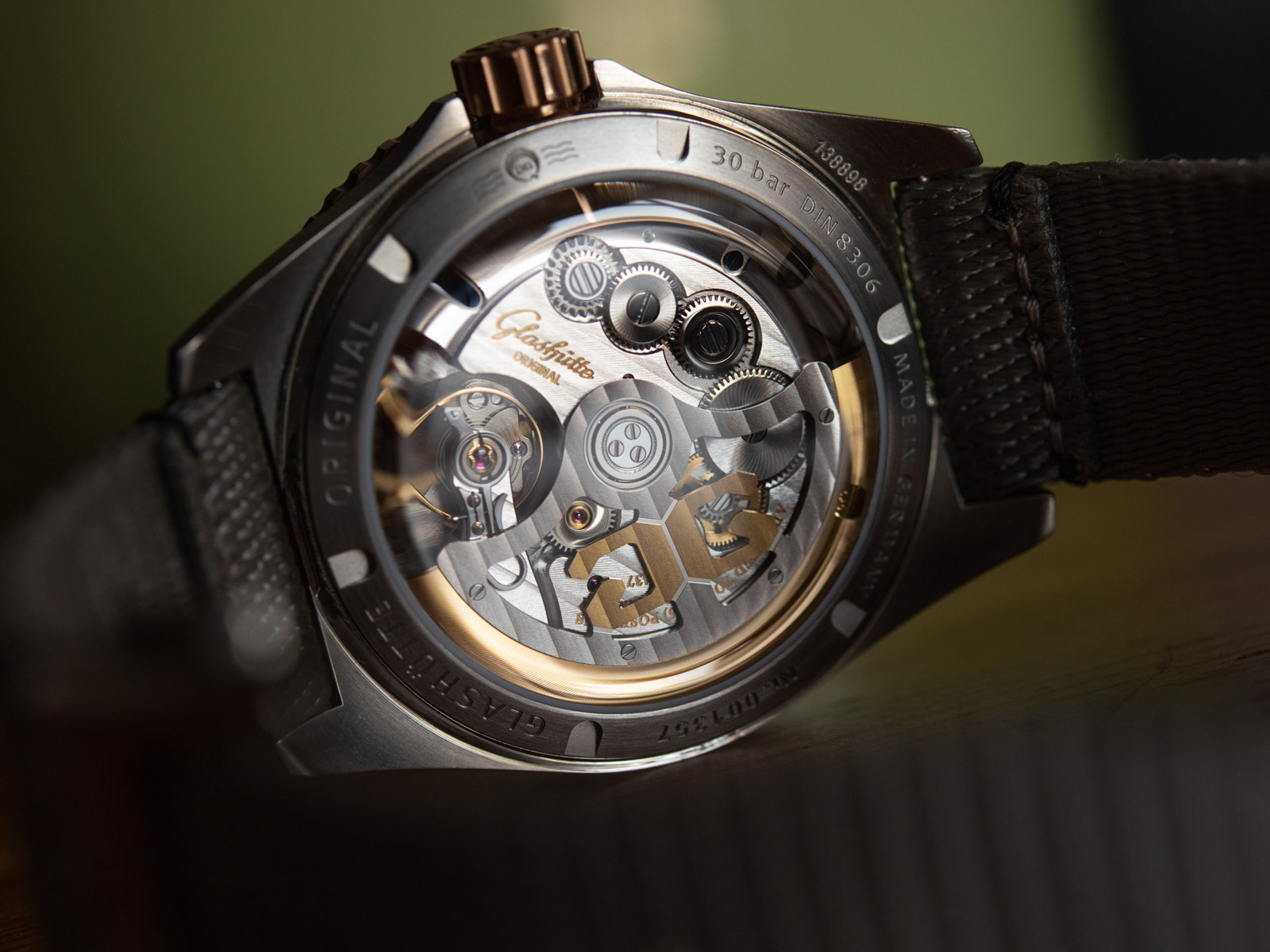 Accompanied by a smaller, 39.5mm “SeaQ” variant — one that I wish had something more to its name to avoid confusion — the SeaQ Panorama Date is the higher-end version with a larger, more refined self-winding caliber that is shown off both on the back by a domed sapphire crystal caseback and on the front, by the presence of the manufacture’s Panorama Date function. A larger date display with two concentric discs is located on the same plane for a more elegant layout and easier legibility. The Glashütte Original Manufactory Calibre 36-13 offers an impressive 100-hour power reserve (a day longer than the white gold Rolex Yacht-Master 42, and two full days longer than a Rolex Submariner) matched to a modern and sports-ready 4Hz operating frequency. A 21k-gold oscillation weight, rate adjustment through the variable moment of inertia screws in the balance wheel, a black-polished swan-neck fine adjustment spring, and a silicon hairspring extend the list of old-school and new-school horological prowess in the SeaQ Panorama Date.
Accompanied by a smaller, 39.5mm “SeaQ” variant — one that I wish had something more to its name to avoid confusion — the SeaQ Panorama Date is the higher-end version with a larger, more refined self-winding caliber that is shown off both on the back by a domed sapphire crystal caseback and on the front, by the presence of the manufacture’s Panorama Date function. A larger date display with two concentric discs is located on the same plane for a more elegant layout and easier legibility. The Glashütte Original Manufactory Calibre 36-13 offers an impressive 100-hour power reserve (a day longer than the white gold Rolex Yacht-Master 42, and two full days longer than a Rolex Submariner) matched to a modern and sports-ready 4Hz operating frequency. A 21k-gold oscillation weight, rate adjustment through the variable moment of inertia screws in the balance wheel, a black-polished swan-neck fine adjustment spring, and a silicon hairspring extend the list of old-school and new-school horological prowess in the SeaQ Panorama Date.
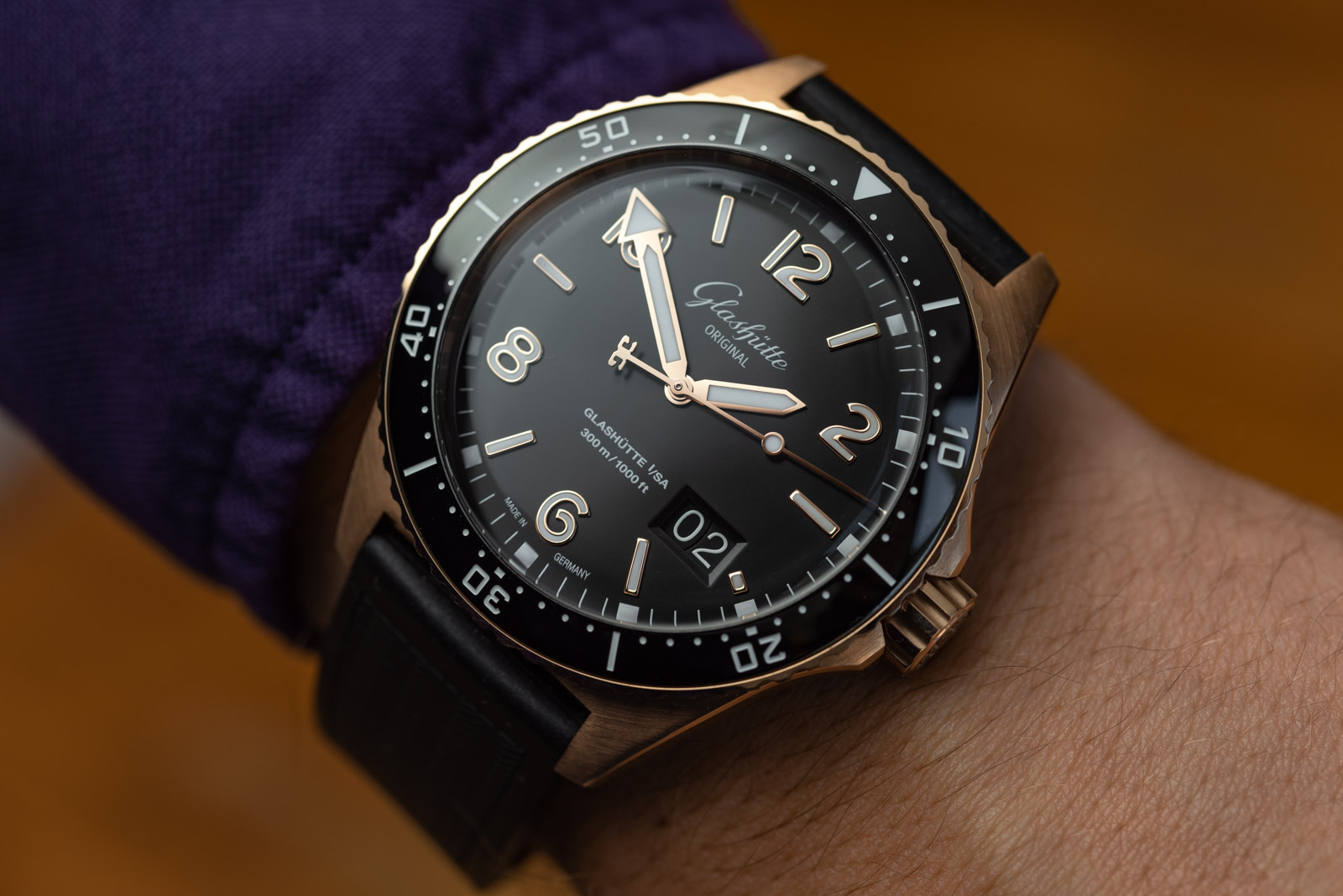 Looks-wise, as I came to learn through extended wear, the SeaQ isn’t as straightforward as it first appears. Glashütte Original, in my mind, has always been a brand that doesn’t really do outrageous designs — the Seventies is just about as crazy as they get these days and, guess what, it happens to be one of their best-selling collections. What GO does rather more, however, is get these arguably more ordinary designs to a level of quality and with a degree of consistency that is scarcely matched by its peers. And the SeaQ Panorama Date is no different.
Looks-wise, as I came to learn through extended wear, the SeaQ isn’t as straightforward as it first appears. Glashütte Original, in my mind, has always been a brand that doesn’t really do outrageous designs — the Seventies is just about as crazy as they get these days and, guess what, it happens to be one of their best-selling collections. What GO does rather more, however, is get these arguably more ordinary designs to a level of quality and with a degree of consistency that is scarcely matched by its peers. And the SeaQ Panorama Date is no different.
 As such, the SeaQ Panorama Date looks rather straightforward upon first sight and it is only through extended wear that one gets to appreciate the number of special details and extra work that Glashütte Original has put into it. Having experienced my fair share of prima facie exciting watches that soon turn out to be either boring or skin-deep in their qualities, today, I’d much rather take a watch that will entertain me in the long-term. And doing that takes subtle details that only show in specific types of light, viewing angles and the like, as opposed to a comical WHAM! thrown in my face only to later reveal compromised artisanship.
As such, the SeaQ Panorama Date looks rather straightforward upon first sight and it is only through extended wear that one gets to appreciate the number of special details and extra work that Glashütte Original has put into it. Having experienced my fair share of prima facie exciting watches that soon turn out to be either boring or skin-deep in their qualities, today, I’d much rather take a watch that will entertain me in the long-term. And doing that takes subtle details that only show in specific types of light, viewing angles and the like, as opposed to a comical WHAM! thrown in my face only to later reveal compromised artisanship.
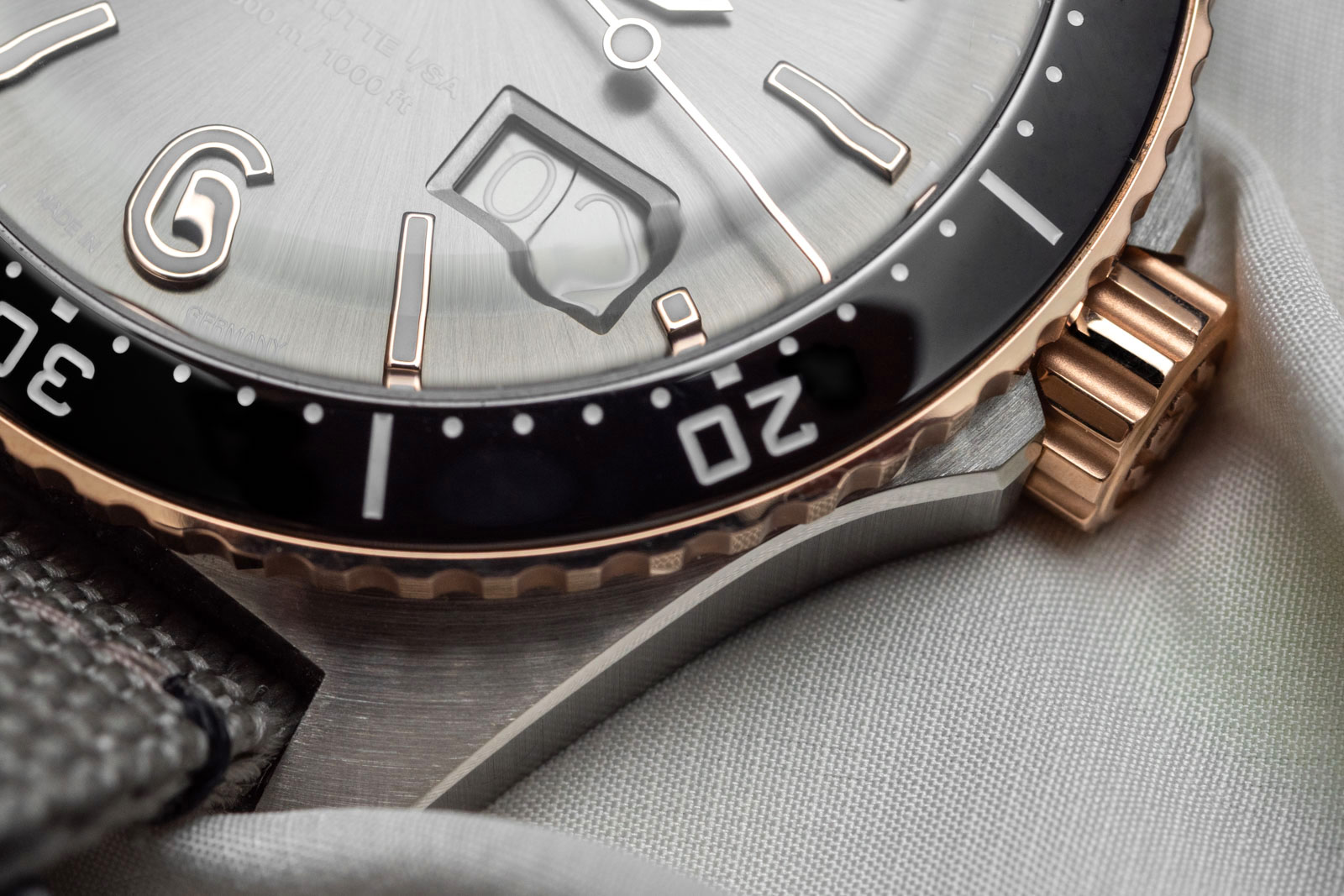 With its long-flowing case profile on one side and neatly integrated crown guards on the other, the 43.20mm diameter case is, well, a case in point. It doesn’t have countless facets or carefully welded lugs. What it does have is an overarching feel of quality that goes from the in-the-metal impression of the thing through the execution of the brushed and polished surfaces to the machining of the bezel, crown, and caseback. Maybe you can relate to this one: With a select few products made by a select few manufactures (within and outside the watch industry), I get the impression that said product is made the way it is because the people who made it don’t appear to know how to do it any worse. In other words, they don’t appear to have given in to the notion of wilfully shaving off quality details in pursuit of saving costs or making production easier.
With its long-flowing case profile on one side and neatly integrated crown guards on the other, the 43.20mm diameter case is, well, a case in point. It doesn’t have countless facets or carefully welded lugs. What it does have is an overarching feel of quality that goes from the in-the-metal impression of the thing through the execution of the brushed and polished surfaces to the machining of the bezel, crown, and caseback. Maybe you can relate to this one: With a select few products made by a select few manufactures (within and outside the watch industry), I get the impression that said product is made the way it is because the people who made it don’t appear to know how to do it any worse. In other words, they don’t appear to have given in to the notion of wilfully shaving off quality details in pursuit of saving costs or making production easier.
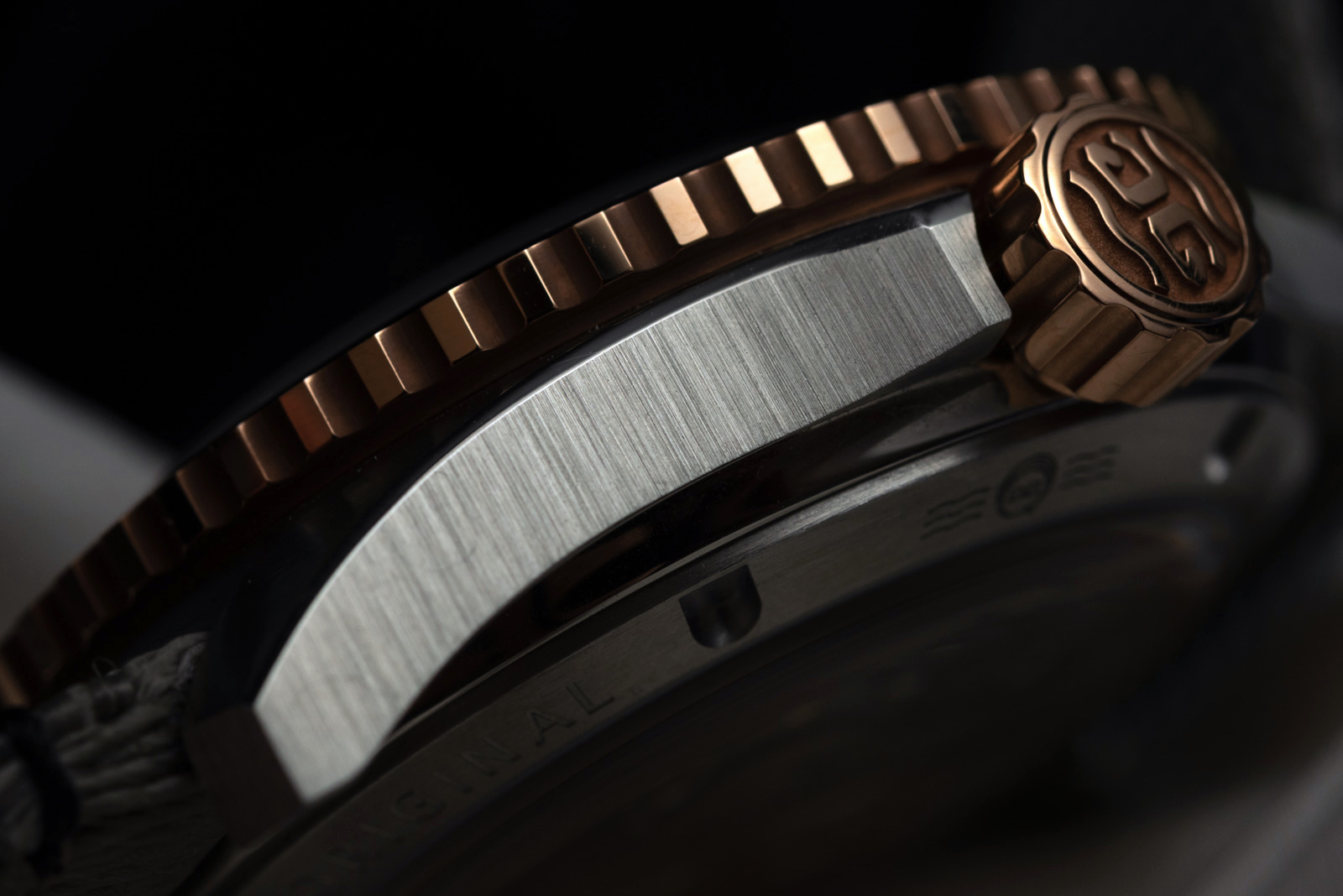 When everything, yes, even luxury watches, is plagued by cost optimization and outsourcing to the cheapest supplier, you start to have an eye for details that don’t appear to be “as nice as they used to be.” While I was, at first sight, nigh on turned off by the SeaQ’s rather simplistic take on a sports-dive watch, it has managed to pull me back in completely by being full of details and components that, to me, indicate that a watchmaker or an engineer or a CNC-operator or a case polisher, i.e., a quality-minded human being had given that particular part their full attention.
When everything, yes, even luxury watches, is plagued by cost optimization and outsourcing to the cheapest supplier, you start to have an eye for details that don’t appear to be “as nice as they used to be.” While I was, at first sight, nigh on turned off by the SeaQ’s rather simplistic take on a sports-dive watch, it has managed to pull me back in completely by being full of details and components that, to me, indicate that a watchmaker or an engineer or a CNC-operator or a case polisher, i.e., a quality-minded human being had given that particular part their full attention.
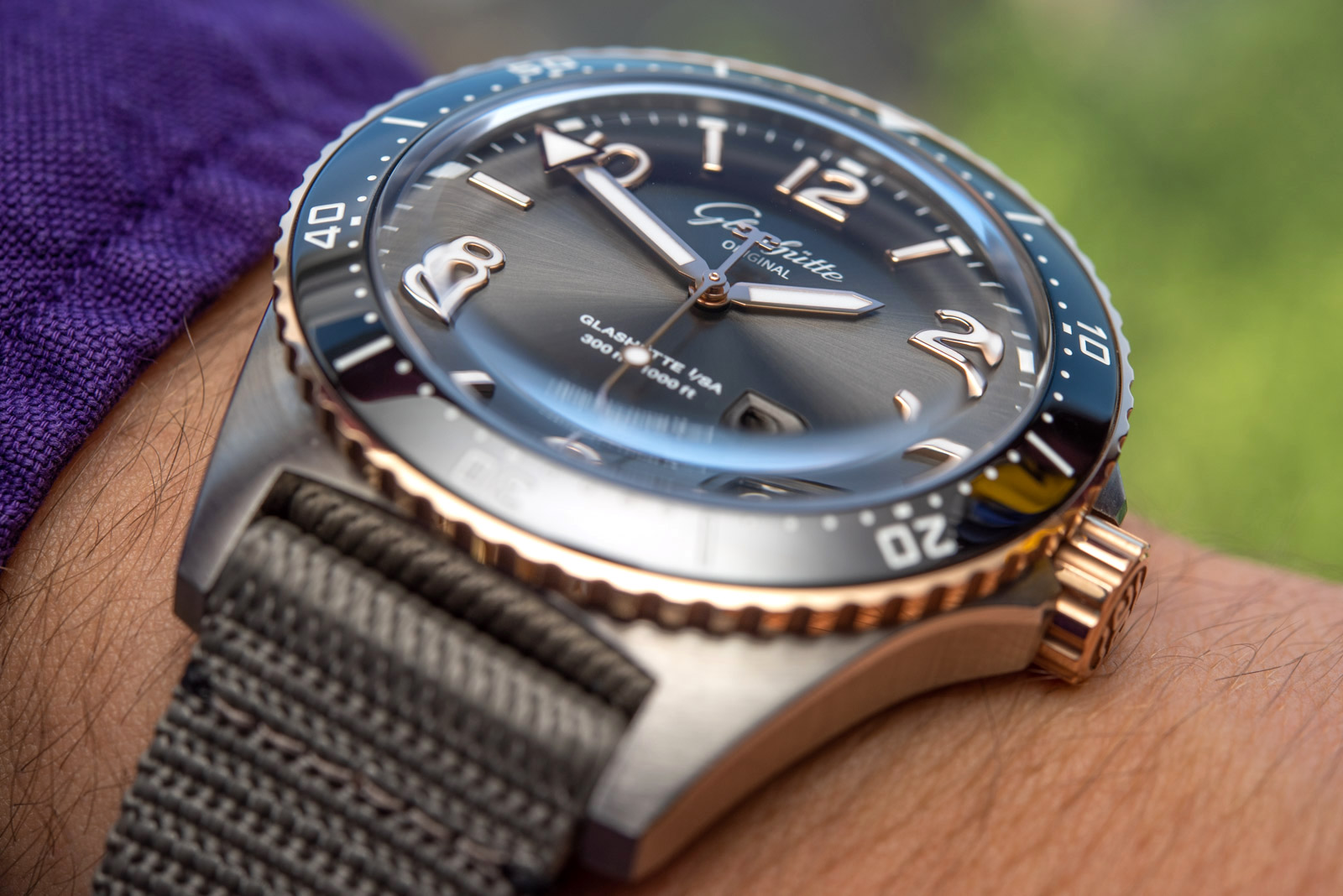 That said, the thing remains that you really do have to know watches very well, and you do have to have the SeaQ Panorama Date on your wrist and out there in the real world to appreciate the effort Glashütte Original put forth in the making of this piece. To its credit, the “bi-color,” i.e., two-tone construction brings its strengths to the fore, with the sheen of a red gold bezel, crown, and dial components adding some much welcome vibrance to the mix. To that end, the domed sapphire crystal on the front has its steep-angled edges and flat top done in a way that the image remains extremely sharp and clear without any distortions outside of the ridge around the edge. Around the periphery, this creates a strange droplet kind of effect as it melts the indices and date window into Dalí-esque shapes while adding depth to the overall picture.
That said, the thing remains that you really do have to know watches very well, and you do have to have the SeaQ Panorama Date on your wrist and out there in the real world to appreciate the effort Glashütte Original put forth in the making of this piece. To its credit, the “bi-color,” i.e., two-tone construction brings its strengths to the fore, with the sheen of a red gold bezel, crown, and dial components adding some much welcome vibrance to the mix. To that end, the domed sapphire crystal on the front has its steep-angled edges and flat top done in a way that the image remains extremely sharp and clear without any distortions outside of the ridge around the edge. Around the periphery, this creates a strange droplet kind of effect as it melts the indices and date window into Dalí-esque shapes while adding depth to the overall picture.
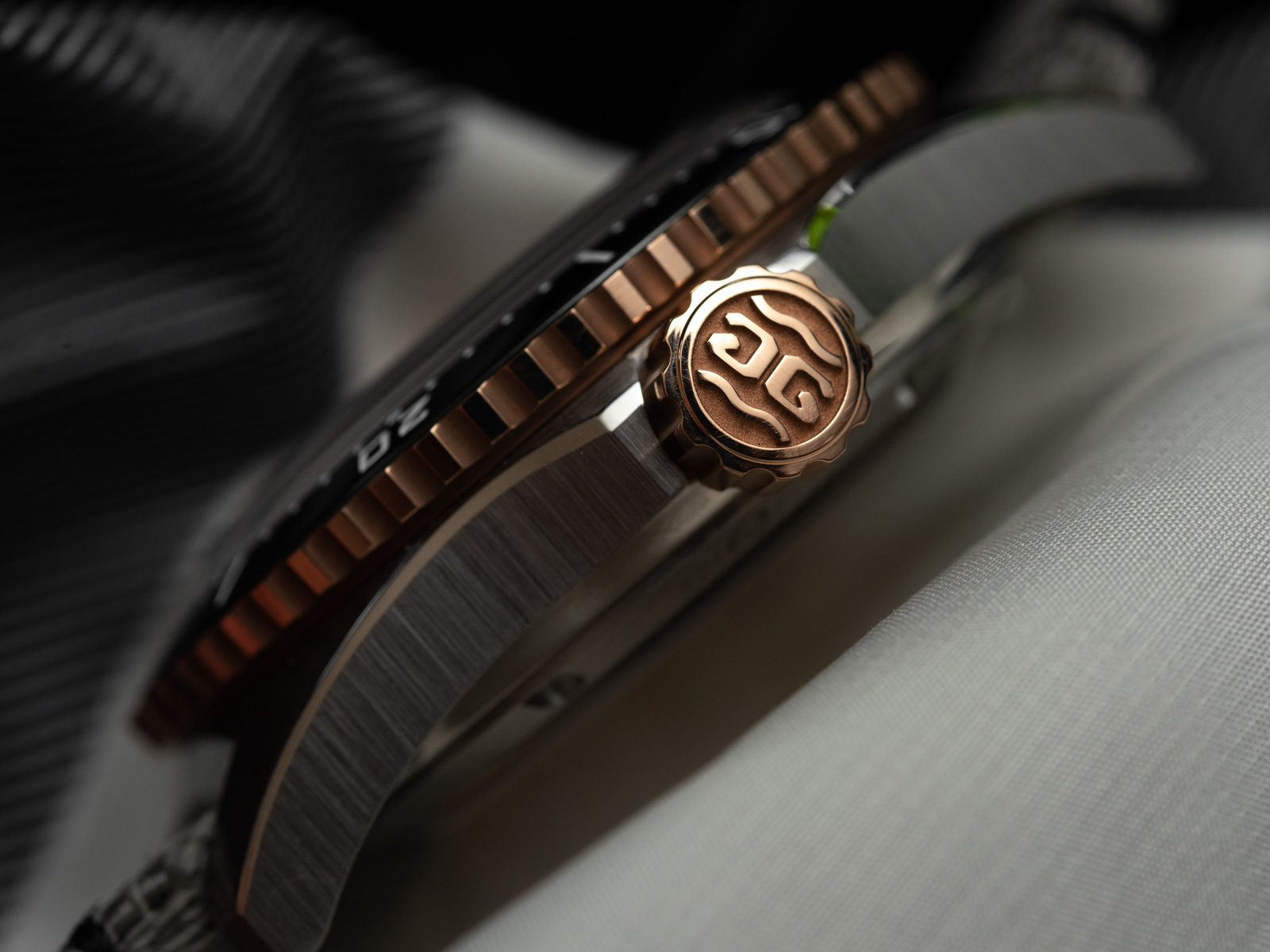 The quality of the case components, although I wouldn’t go so far as to say is in a league of its own, definitely belongs among the very best in class. To my surprise, this is exemplified by the two-tone version better than the solid 18k red gold variant — the latter, for the price and for being a solid gold watch, could do with a bit of extra flair in terms of decorations, variety in surface treatments, or the like. The two-tone, however, really shines. I tried my best to use various types of lighting and photography techniques, but, as I said, the strong points and the solid feel of this level of execution alone really translate through in-the-metal appreciation and real-world wear. And I can’t stress this enough: If it takes many polished facets and complex designs to impress you, no one is to blame you. But if you are of a more relaxed and traditional taste in watch case design and happen to have a keen eye for excellent quality, then the SeaQ, and Glashütte Original in general, will likely resonate with you.
The quality of the case components, although I wouldn’t go so far as to say is in a league of its own, definitely belongs among the very best in class. To my surprise, this is exemplified by the two-tone version better than the solid 18k red gold variant — the latter, for the price and for being a solid gold watch, could do with a bit of extra flair in terms of decorations, variety in surface treatments, or the like. The two-tone, however, really shines. I tried my best to use various types of lighting and photography techniques, but, as I said, the strong points and the solid feel of this level of execution alone really translate through in-the-metal appreciation and real-world wear. And I can’t stress this enough: If it takes many polished facets and complex designs to impress you, no one is to blame you. But if you are of a more relaxed and traditional taste in watch case design and happen to have a keen eye for excellent quality, then the SeaQ, and Glashütte Original in general, will likely resonate with you.
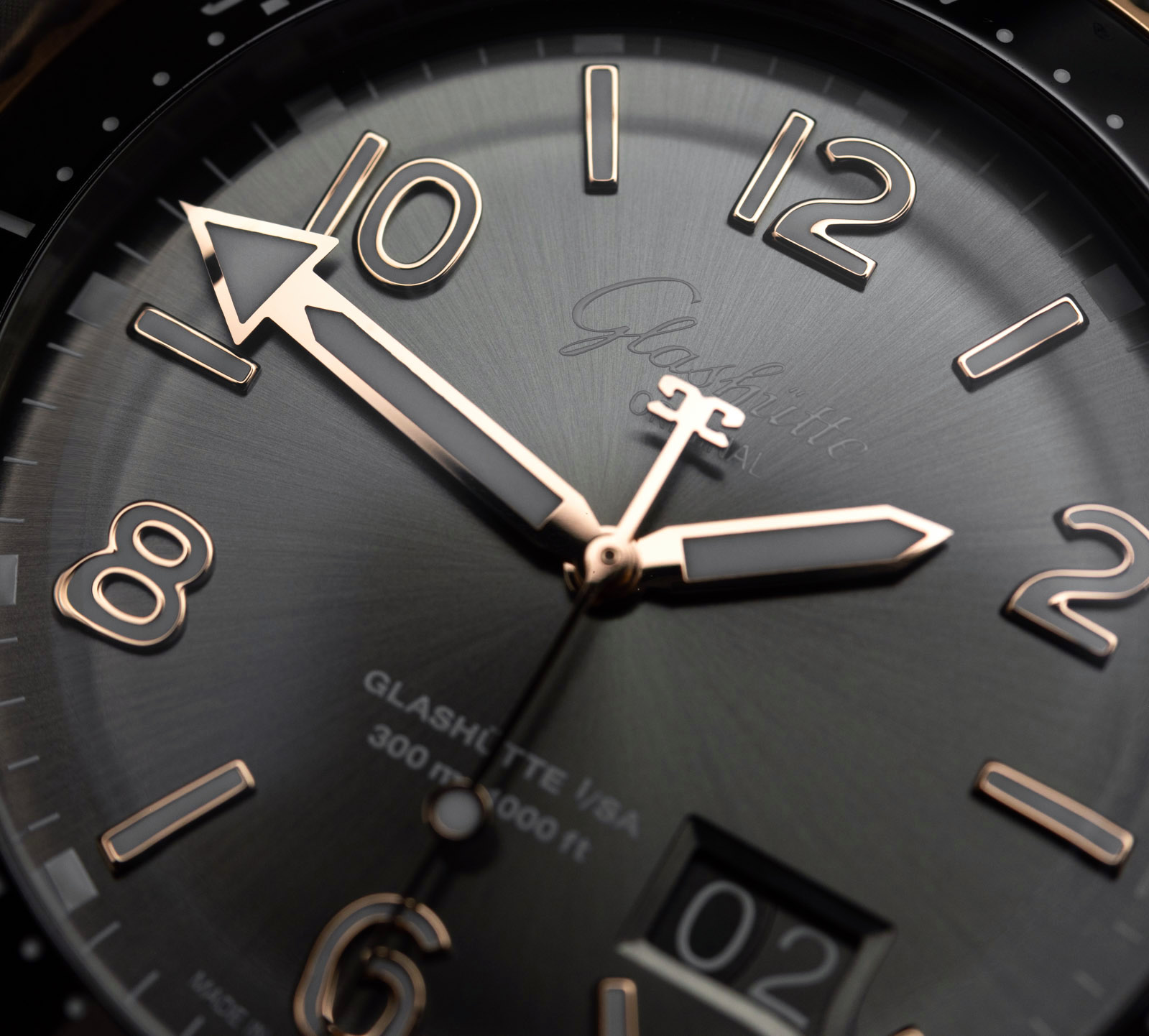 Likewise, the dial exhibits the same pattern of timid first impressions trailed by numerous subtle (and expensive) details. Made in GO’s own dial manufactory in Pforzheim, Germany, one gets the impression that this facility has, by now, benefitted from having to focus exclusively on just one brand. How so? By fine-tuning subtle components to yet higher levels of quality and intricacy. The Glashütte Original logo under 12 is a good example. (I have told you we’ll be talking small details, haven’t I?) Sometimes the text is in crisp white that almost jumps off the gray backdrop on the two-tone SeaQ, while at others (as pictured directly above) it looks gray, and it is only its extremely minute texture and relieved structure that makes it stand out. The “GLASHÜTTE I/SA” over six o’clock on the same image looks white — but it can do the same as the logo.
Likewise, the dial exhibits the same pattern of timid first impressions trailed by numerous subtle (and expensive) details. Made in GO’s own dial manufactory in Pforzheim, Germany, one gets the impression that this facility has, by now, benefitted from having to focus exclusively on just one brand. How so? By fine-tuning subtle components to yet higher levels of quality and intricacy. The Glashütte Original logo under 12 is a good example. (I have told you we’ll be talking small details, haven’t I?) Sometimes the text is in crisp white that almost jumps off the gray backdrop on the two-tone SeaQ, while at others (as pictured directly above) it looks gray, and it is only its extremely minute texture and relieved structure that makes it stand out. The “GLASHÜTTE I/SA” over six o’clock on the same image looks white — but it can do the same as the logo.
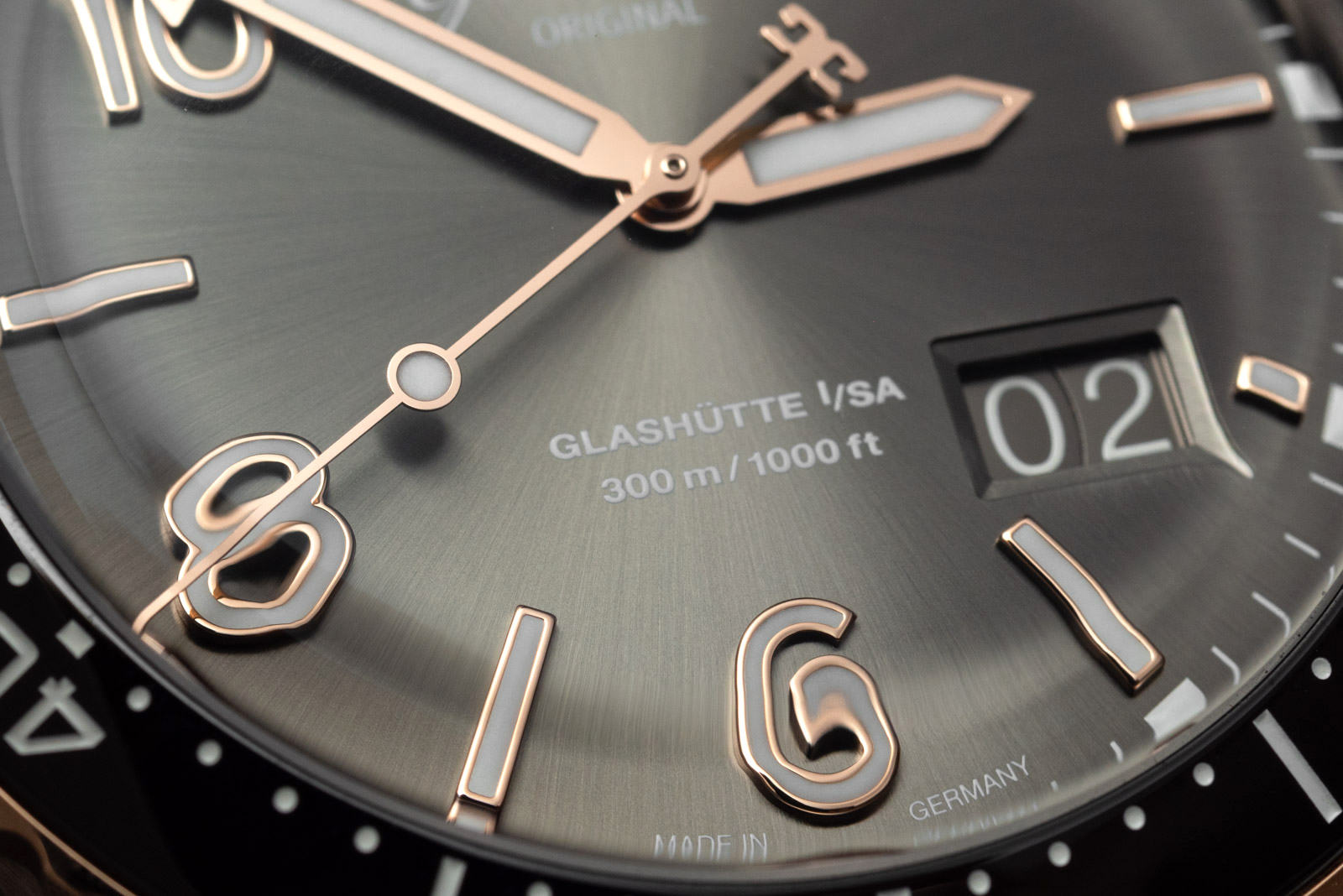 The indices and hands are all lumed and are all applied by hand over a sunburst finished, galvanic gray dial on the bi-color, and galvanic black dial on the solid 18k version. Framing the dial is a red gold bezel with black ceramic and white, non-luminescent markings. A ceramic bezel insert at this price point is an absolute must, just as well as the solid, reassuring feel of its operation. So that’s those two boxes ticked — I just wonder whether the SeaQ Panorama Date would’ve looked better or worse with a lumed pip inside the zero marker triangle of the bezel. Having visited Glashütte Original a few times over the years and spoken with some of its engineers and watchmakers, I have no doubt that they considered that as a possibility — and decided against it. Interestingly, even without it, the SeaQ Panorama Date is a dive watch that complies with the German DIN8306 standard for divers’ watches, as is indicated by the etching in the periphery of the caseback.
The indices and hands are all lumed and are all applied by hand over a sunburst finished, galvanic gray dial on the bi-color, and galvanic black dial on the solid 18k version. Framing the dial is a red gold bezel with black ceramic and white, non-luminescent markings. A ceramic bezel insert at this price point is an absolute must, just as well as the solid, reassuring feel of its operation. So that’s those two boxes ticked — I just wonder whether the SeaQ Panorama Date would’ve looked better or worse with a lumed pip inside the zero marker triangle of the bezel. Having visited Glashütte Original a few times over the years and spoken with some of its engineers and watchmakers, I have no doubt that they considered that as a possibility — and decided against it. Interestingly, even without it, the SeaQ Panorama Date is a dive watch that complies with the German DIN8306 standard for divers’ watches, as is indicated by the etching in the periphery of the caseback.
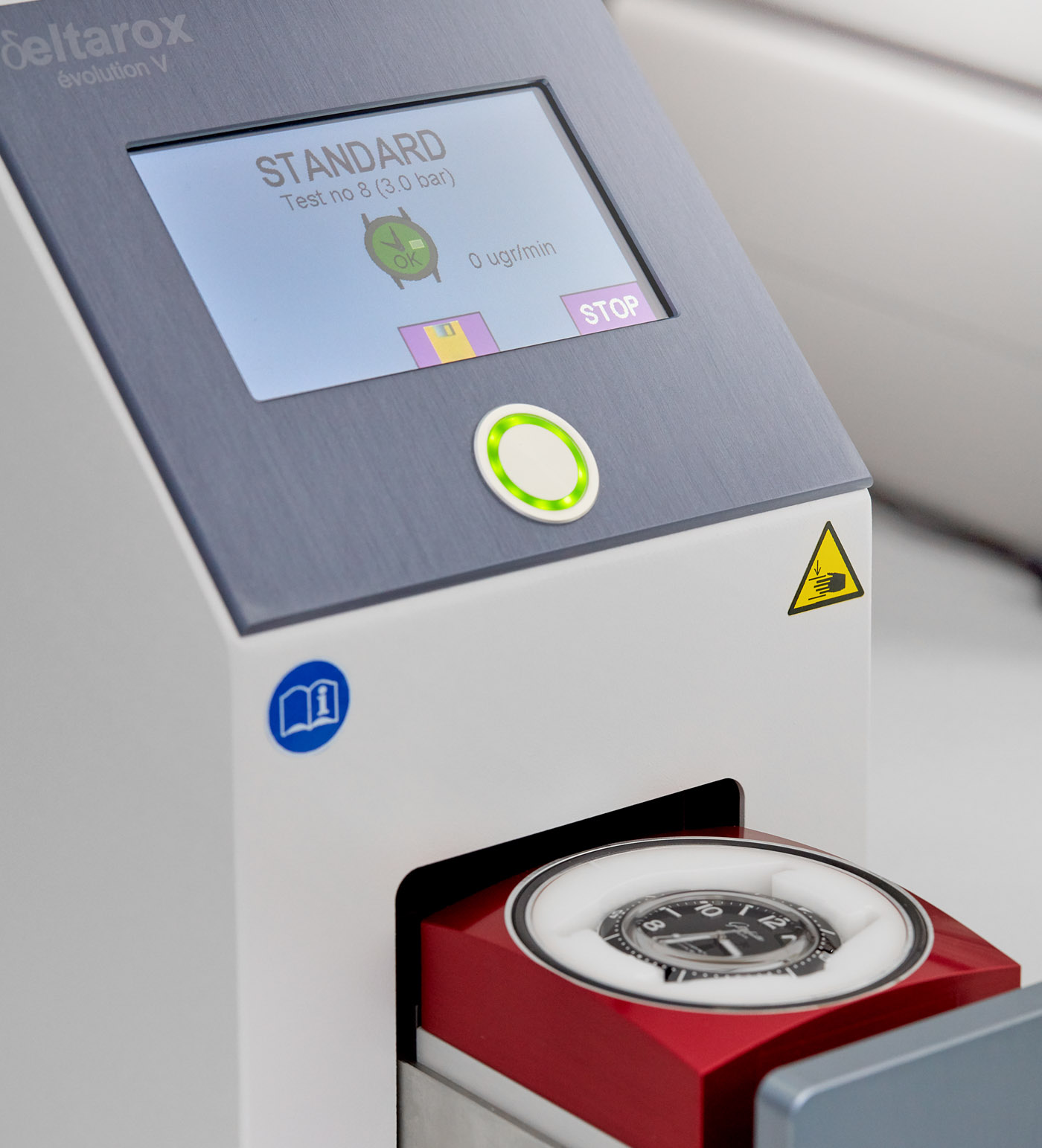
If it is water-resistant credentials you are after, you’ll want to know that Glashütte Original has installed an all-new water-resistance testing department (yes, that) in its manufacture. Condensation tests controlled to a tenth of a centigrade, as well as air pressure and water pressure tests, are performed on some proper-expensive devices in-house, all to 125% of the 300m rated water-resistance of the SeaQ Panorama Date. The zaniest test of them all is one that checks each and every SeaQ Panorama Date for air mass flow in overpressure, checking all its seals for micrograms (a millionth of a gram) of a leak. So if you were expecting the German manufacture to approach the concept of a sports watch with a slapdash attitude, you’ve come to the wrong place.

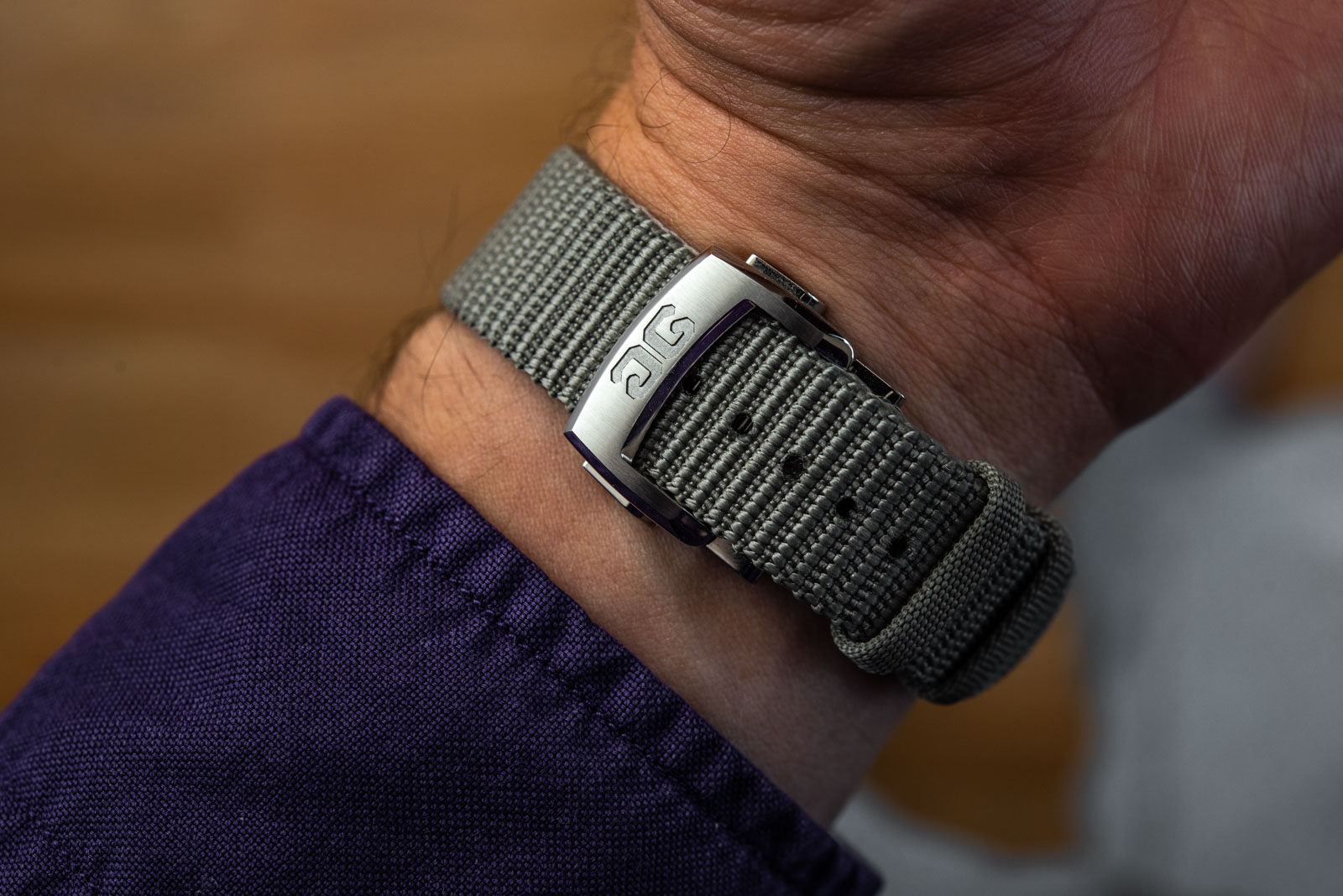 Both the Glashütte Original SeaQ Panorama Date bi-color and the solid 18k red gold version are available on a selection of two straps. One is a black rubber strap with a classy and rather intricately realized fishbone pattern, while the other is a strap woven from synthetic material. Unlike so many similar straps, the synthetic material in this instance is not abrasive to the skin, not even around its edges (the usual culprit with these, in my experience). The buckle is a double-folding clasp that is absolutely beautifully made — the one rendered in solid 18k gold could go on any six-figure priced watch I’ve ever handled, especially without the strap fed through it and its inner mechanisms revealed.
Both the Glashütte Original SeaQ Panorama Date bi-color and the solid 18k red gold version are available on a selection of two straps. One is a black rubber strap with a classy and rather intricately realized fishbone pattern, while the other is a strap woven from synthetic material. Unlike so many similar straps, the synthetic material in this instance is not abrasive to the skin, not even around its edges (the usual culprit with these, in my experience). The buckle is a double-folding clasp that is absolutely beautifully made — the one rendered in solid 18k gold could go on any six-figure priced watch I’ve ever handled, especially without the strap fed through it and its inner mechanisms revealed.


Unlike some of GO’s leather straps that require frankly unreasonable amounts of wear and breaking in for them to be comfortable to wear, both the synthetic strap and the rubber one follow the shape of the wrist neatly right out of the box. The integration of the inner folding mechanisms into the overall shape is much better this time around, as well. One thing to keep in mind with the synthetic strap is that it takes rather long for it to dry up once you get it wet. Sounds strange, but it’s something to keep in mind when choosing between the black rubber or the gray woven strap.
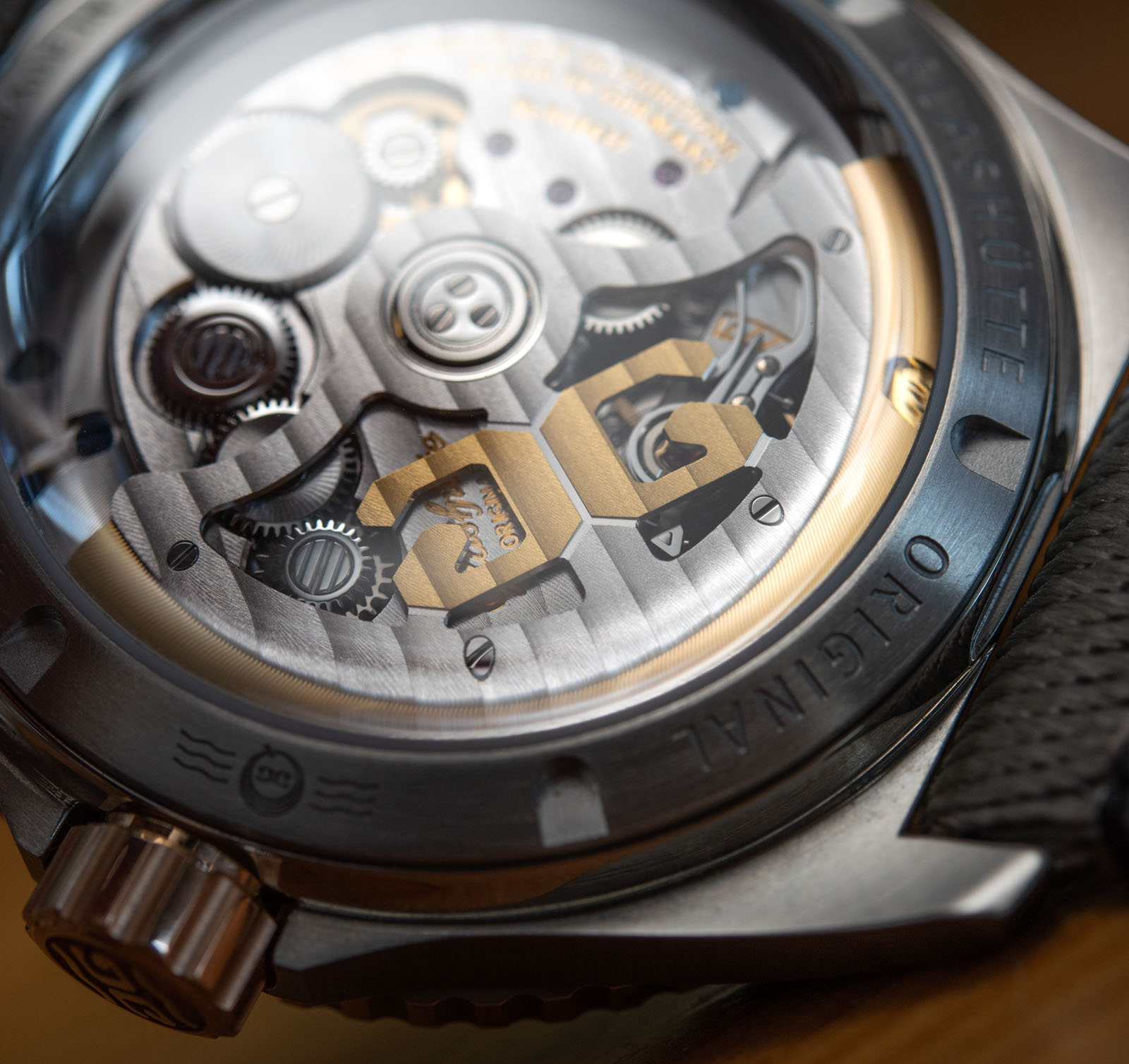
 Overall wearability of the SeaQ Panorama Date is good. The watch does not slide around too much and nothing digs into the top of the wrist. Although the crown is substantial (it’s a massive and beautifully made crown is what I’m trying to say), when it’s securely screwed down it sits well in between the crown guards. The solid gold version, given the extra heft of its precious case, wobbles about a bit more than does the two-tone version — then again, if you are bothered by the weight of gold, then it probably isn’t for you anyway… Or maybe you should try some other “solid gold” luxury watches out in this segment — a gut instinct of mine is telling me brands lately have been getting clever with hollowing those cases out as much as they can. Not this one, though.
Overall wearability of the SeaQ Panorama Date is good. The watch does not slide around too much and nothing digs into the top of the wrist. Although the crown is substantial (it’s a massive and beautifully made crown is what I’m trying to say), when it’s securely screwed down it sits well in between the crown guards. The solid gold version, given the extra heft of its precious case, wobbles about a bit more than does the two-tone version — then again, if you are bothered by the weight of gold, then it probably isn’t for you anyway… Or maybe you should try some other “solid gold” luxury watches out in this segment — a gut instinct of mine is telling me brands lately have been getting clever with hollowing those cases out as much as they can. Not this one, though.
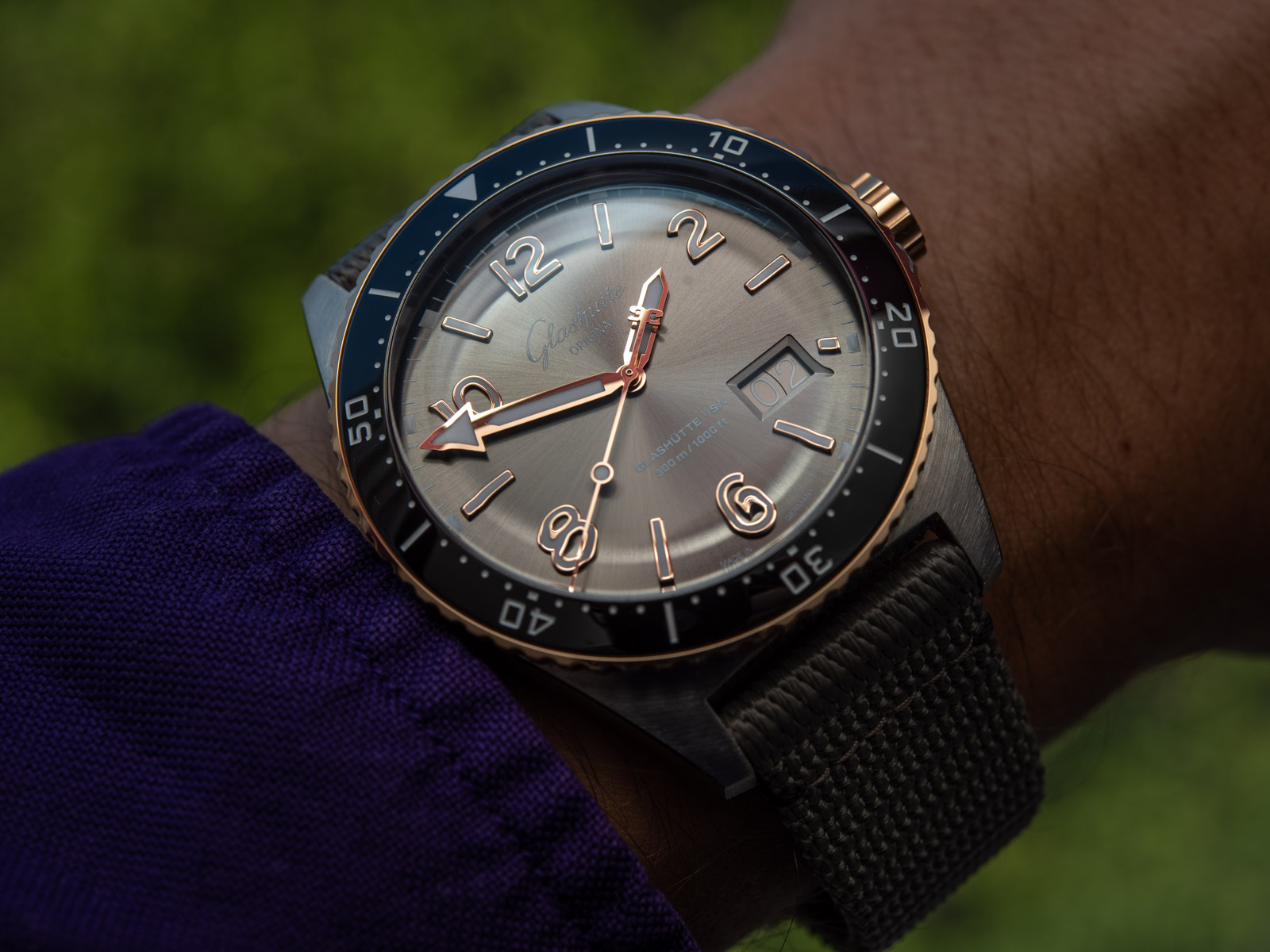
Whether Glashütte Original’s exceptionally solid feel, all-encompassing focus on quality of execution, and feature-packed in-house movement justify the high cost is up to you to decide. The key that I found to Glashütte Original is not to approach it with the same requirement of instant gratification we have been programmed to expect by high-profile luxury brands. Upon walking out from a boutique with a status brand that even your non-watch-savvy neighbor recognizes, you are instantly gratified by showing to the world that you are part of that elite club. Yuck. Upon wearing an “iconic design” (this term still gives me the wrong kind of chills), again, to some, you no longer appear the design-savvy connoisseur but another try-hard that wants to play ball. Not judging, just laying out what the realities are these days, at least in some parts of the world.
However, in my experience — and that of so many others — the novelty factor of both those gratifications wears off sooner than later. What is to be appreciated in how GO does things is in the number and, again, the execution of small details that cumulatively attain the aforementioned overarching feel of quality. All without the in-your-faceness of a brand all your neighborhood wears, or the wannabe vibe of an octagonal design.
Water-resistant to three hundred meters and tested way beyond that, the SeaQ Panorama Date has only one pressing challenge left to face — and that lies in it justifying its price. The Glashütte Original SeaQ Panorama Date in bi-color steel and gold costs $15,100, while the solid gold version costs a whopping $24,900. Both are comparable to two-tone Rolex Submariner and solid gold Yacht-Master prices, and that’s some tough competition if there ever was one. Between the features and quality of the movement, as well as the bespoke execution of its exterior details, the SeaQ Panorama Date has enough to compare favorably against its competition — the challenge remains in getting prospective buyers to spend enough time scrutinizing said details and the spec sheet of this line of watches. Once they do, a lot of them will likely find these favorable, and they’ll be rewarded for going for the more subtle choice. You can see other variations of the SeaQ at the brand’s website.
Necessary Data:
>Brand: Glashütte Original
>Model: SeaQ Panorama Date bi-color (two-tone) reference 1-36-13-04-91-08 and in 18kt solid gold reference 1-36-13-03-90-33
>Price: $15,100 – $24,900 USD
>Size: 43.20mm-wide, 15.65mm-thick
>When reviewer would personally wear it: The two-tone? Any time.
>Friend we’d recommend it to first: Sports-watch lover expecting all-round quality, looking for something off the beaten path.
>Best characteristic of watch: Exceptional quality and execution throughout. High-end movement.
>Worst characteristic of watch: The price. If these were around four grand less, they could cause some serious headache to the competition.

